United States historic place
| Bannack Historic District | |
| U.S. National Register of Historic Places | |
| U.S. National Historic Landmark District | |
 Main street in Bannack Main street in Bannack | |
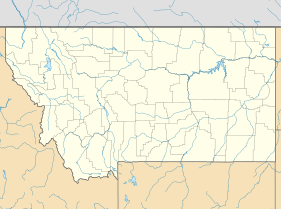 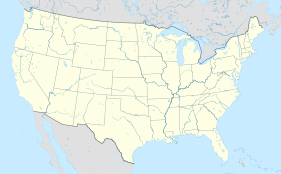 | |
| Location | Beaverhead County, Montana |
|---|---|
| Nearest city | Dillon, Montana |
| Coordinates | 45°09′40″N 112°59′44″W / 45.16111°N 112.99556°W / 45.16111; -112.99556 |
| Area | 1 square mile (2.6 km) |
| Built | 1862 |
| NRHP reference No. | 66000426 |
| Significant dates | |
| Added to NRHP | October 15, 1966 |
| Designated NHLD | July 4, 1961 |
Bannack is a ghost town in Beaverhead County, Montana, United States, located on Grasshopper Creek, approximately 11 miles (18 km) upstream from where Grasshopper Creek joins with the Beaverhead River south of Dillon. Founded in 1862, the town is a National Historic Landmark managed by the state of Montana as Bannack State Park.
History
| This section needs additional citations for verification. Please help improve this article by adding citations to reliable sources in this section. Unsourced material may be challenged and removed. Find sources: "Bannack, Montana" – news · newspapers · books · scholar · JSTOR (January 2023) (Learn how and when to remove this message) |
Founded in 1862 and named after the local Bannock natives, Bannack was the site of a major gold discovery in 1862, and served as the capital of Montana Territory briefly in 1864, until the capital was moved to Virginia City. Bannack continued as a mining town, though with a dwindling population. The last residents left in the 1970s.
At its peak, Bannack had a population of about ten thousand. Extremely remote, it was connected to the rest of the world only by the Montana Trail. There were three hotels, three bakeries, three blacksmith shops, two stables, two meat markets, a grocery store, a restaurant, a brewery, a billiard hall, and four saloons. Though all of the businesses were built of logs, some had decorative false fronts.
Among the town's founders was Dr. Erasmus Darwin Leavitt, a physician born in Cornish, New Hampshire, who gave up medicine for a time to become a gold miner. Dr. Leavitt arrived in Bannack in 1862, and alternately practiced medicine and mined for gold with pick and shovel. "Though some success crowned his labors," according to a history of Montana by Joaquin Miller, "he soon found that he had more reputation as a physician than as a miner, and that there was greater profit in allowing someone else to wield his pick and shovel while he attended to his profession." Subsequently, Dr. Leavitt moved on to Butte, Montana, where he devoted the rest of his life to his medical practice
Bannack's sheriff, Henry Plummer, was accused by some of secretly leading a ruthless band of road agents, with early accounts claiming that this gang was responsible for over a hundred murders in the Virginia City and Bannack gold fields and trails to Salt Lake City. However, because only eight deaths are historically documented, some modern historians have called into question the exact nature of Plummer's gang, while others deny the existence of the gang altogether. In any case, Plummer and two compatriots, both deputies, were hanged, without trial, at Bannack on January 10, 1864. A number of Plummer's associates were lynched and others banished on pain of death if they ever returned. Twenty-two individuals were accused, informally tried, and hanged by the Vigilance Committee (the Montana Vigilantes) of Bannack and Virginia City. Nathaniel Pitt Langford, the first superintendent of Yellowstone National Park, was a member of that vigilance committee.
A number of mining camps dotted the banks of Grasshopper Creek during the gold booms, starting at Bannack downstream almost to where the stream joins Beaverhead River. While many were short lived and considered just extensions of Bannack, others were designated towns of their own. Yankee Flats adjoined Bannack and was referred to as an "addition" to Bannack. Centerville and Marysville, about 1 mile (1.6 km) downstream, were both laid out as little camps in the winter on 1862. By the following March, a townsite company had laid out and platted Centerville. However, Marysville, named for early arrival Mary Wadam, gained more people and so contemporary maps alternately used the name on record, Centerville, or the name used by locals, Marysville. Dogtown was south of and "near" Bannack in 1866. It was named for the numerous stray dogs, and had a blacksmith shop, saloon, and grocery store. Jerusalem (also New Jerusalem or Jerusalem Bar) was located 2 miles (3.2 km) downstream of Bannack. Bon Accord, about 5 miles (8.0 km) downstream, was a larger camp that saw a revival in the 1890s, and had a post office and school district. White's Bar, located possibly 10 miles (16 km) downstream, was where John White and Company made the initial discovery of gold in 28 Jul 1862.
Climate
Dillon 18 WSW is a weather station located near Bannack.
| Climate data for Dillon 18 WSW, Montana, 1991–2020 normals: 5971ft (1820m) | |||||||||||||
|---|---|---|---|---|---|---|---|---|---|---|---|---|---|
| Month | Jan | Feb | Mar | Apr | May | Jun | Jul | Aug | Sep | Oct | Nov | Dec | Year |
| Record high °F (°C) | 53 (12) |
57 (14) |
68 (20) |
76 (24) |
86 (30) |
92 (33) |
93 (34) |
95 (35) |
93 (34) |
82 (28) |
69 (21) |
54 (12) |
95 (35) |
| Mean maximum °F (°C) | 42.5 (5.8) |
44.8 (7.1) |
56.0 (13.3) |
69.2 (20.7) |
76.9 (24.9) |
85.7 (29.8) |
90.7 (32.6) |
90.9 (32.7) |
85.4 (29.7) |
72.8 (22.7) |
59.3 (15.2) |
45.4 (7.4) |
91.8 (33.2) |
| Mean daily maximum °F (°C) | 28.1 (−2.2) |
31.9 (−0.1) |
40.7 (4.8) |
50.2 (10.1) |
60.4 (15.8) |
68.9 (20.5) |
80.9 (27.2) |
79.2 (26.2) |
68.8 (20.4) |
53.4 (11.9) |
38.5 (3.6) |
28.4 (−2.0) |
52.5 (11.4) |
| Daily mean °F (°C) | 18.0 (−7.8) |
20.4 (−6.4) |
29.4 (−1.4) |
37.9 (3.3) |
46.8 (8.2) |
54.0 (12.2) |
62.4 (16.9) |
60.6 (15.9) |
51.8 (11.0) |
39.4 (4.1) |
26.5 (−3.1) |
17.5 (−8.1) |
38.7 (3.7) |
| Mean daily minimum °F (°C) | 7.8 (−13.4) |
9.0 (−12.8) |
18.1 (−7.7) |
25.5 (−3.6) |
33.2 (0.7) |
39.1 (3.9) |
44.0 (6.7) |
42.0 (5.6) |
34.7 (1.5) |
25.3 (−3.7) |
14.6 (−9.7) |
6.5 (−14.2) |
25.0 (−3.9) |
| Mean minimum °F (°C) | −19.2 (−28.4) |
−16.9 (−27.2) |
−1.4 (−18.6) |
11.8 (−11.2) |
17.8 (−7.9) |
28.4 (−2.0) |
35.4 (1.9) |
33.3 (0.7) |
23.1 (−4.9) |
8.7 (−12.9) |
−8.7 (−22.6) |
−21.6 (−29.8) |
−27.9 (−33.3) |
| Record low °F (°C) | −37 (−38) |
−42 (−41) |
−25 (−32) |
2 (−17) |
8 (−13) |
24 (−4) |
29 (−2) |
29 (−2) |
16 (−9) |
−13 (−25) |
−23 (−31) |
−35 (−37) |
−42 (−41) |
| Average precipitation inches (mm) | 0.34 (8.6) |
0.56 (14) |
0.56 (14) |
1.00 (25) |
1.59 (40) |
1.84 (47) |
0.62 (16) |
0.69 (18) |
0.85 (22) |
0.86 (22) |
0.47 (12) |
0.71 (18) |
10.09 (256.6) |
| Source 1: NOAA | |||||||||||||
| Source 2: XMACIS2 (records & monthly max/mins) | |||||||||||||
State park
Sixty historic log, brick, and frame structures remain standing in Bannack, many quite well preserved; most can be explored. The site, now the Bannack Historic District, was declared a National Historic Landmark in 1961. It joined the roster of Montana state parks in 1954. Volunteers work in conjunction with the state to preserve the fabled ghost town.
Bannack Days
Every year, during the third weekend of July, this abandoned town witnesses a historical reconstitution known as "Bannack Days". For two days, Bannack State Park officials organize an event that attempts to revive the times when Bannack was a boom town, re-enacting the day-to-day lives of the miners who lived there during the gold rush. An authentic, old-fashioned breakfast is served in the old Hotel Meade, a well-preserved brick building which was for many years the seat of Beaverhead County, before it became Dillon, Montana.
Physiography
The mines surrounding Bannack are located on both sides of Grasshopper Creek, which flows southeastward through the district and into the Beaverhead River about 12 miles (19 km) downstream.
Gallery
-
 Schoolhouse and Masonic Lodge
Schoolhouse and Masonic Lodge
-
 Hotel Meade
Hotel Meade
-
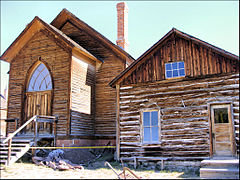 Methodist Church, built in 1877
Methodist Church, built in 1877
-
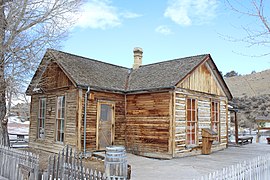 Private home in Bannack
Private home in Bannack
-
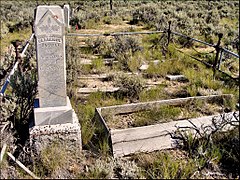 Family plot in cemetery
Family plot in cemetery
-
 Historic landmark plaque
Historic landmark plaque
See also
- List of ghost towns in Montana
- Montana Ghost Town Preservation Society
- List of National Historic Landmarks in Montana
- National Register of Historic Places listings in Beaverhead County, Montana
References
- "Bannack". Geographic Names Information System. United States Geological Survey, United States Department of the Interior.
- "Listing of National Historic Landmarks by State: Montana" (PDF). National Park Service. Archived (PDF) from the original on August 1, 2017. Retrieved June 1, 2018.
- "Bannack State Park". Montana Fish, Wildlife & Parks. Retrieved August 28, 2021.
- Joaquin Miller (1894). "Erasmus Darwin Leavitt". History of Montana. USGENWEB Montana Archives. Archived from the original on February 26, 2012. Retrieved September 1, 2009.
- Hough, Emerson (1907). The Story of the Outlaw. New York: The Outling Publishing Company. pp. 105–126.
- Olin D. Wheeler (1915). "Speech to the Montana Historical Society, April 8, 1912". Nathaniel Pitt Langford: The Vigilante, the Explorer, the Expounder and First Superintendent of Yellowstone Park. Minnesota Historical Society. pp. 631–668.
- "Unwritten Chapters in the Life of Henry Plummer". Augusta, Montana. The Augusta News. January 23, 1930. p. 7.
- "John Henry Morley, who wrote daily reports of State, died 75 years ago". Helena, Montana. The Independent-Record. September 10, 1964. p. 20.
- "On to Beaverhead". Great Falls, Montana. Great Falls Tribune. February 2, 1936. p. 14.
- ^ "Dogtown named because of many canines". Butte, Montana. The Montana Standard. August 15, 1964. p. 22.
- Beaverhead County History Book Association (1990). "Beaverhead County Place Names". The History of Beaverhead County, Volume 1 1800-1920. Logan, Utah: Herff-Jones, Inc. pp. 6–18. ISBN 0-9625987-0-4. Archived from the original on February 6, 2021. Retrieved February 1, 2021.
- "Dillon 18 WSW, Montana 1991-2020 Monthly Normals". Retrieved November 21, 2023.
- "xmACIS". National Oceanic and Atmospheric Administration. Retrieved November 21, 2023.
- "Bannack Historic District". NPGallery. National Park Service. Retrieved June 1, 2018.
- Blanche Higgins Schroer (September 1975). "Bannack Historic District". National Register of Historic Places Inventory Nomination Form. National Park Service. and Accompanying 11 photos, from 1975.
- "Park Origin by Date". Montana State Parks. 2014. Archived from the original on January 1, 2020. Retrieved May 28, 2018.
- Kearse, Hannah (May 10, 2021). "Volunteers help preserve Montana ghost town". KECI. Retrieved May 13, 2021.
- "Bannack Days". Bannack State Park and Bannack Association. Archived from the original on September 28, 2016. Retrieved August 28, 2021.
- Spectrum Engineering & Abandoned Mine Reclamation Bureau Montana 1992, p. 1.
Bibliography
- Spectrum Engineering; Abandoned Mine Reclamation Bureau Montana (1992). Bannack State Park Project. Billings, Montana: Montana State Library. p. 194.
External links
- Bannack State Park Montana Fish, Wildlife & Parks
- Bannack State Park Bannack State Park and Bannack Association
| Municipalities and communities of Beaverhead County, Montana, United States | ||
|---|---|---|
| County seat: Dillon | ||
| City |  | |
| Town | ||
| CDPs | ||
| Other communities | ||
| Ghost towns | ||
| U.S. National Register of Historic Places | |
|---|---|
| Topics | |
| Lists by state |
|
| Lists by insular areas | |
| Lists by associated state | |
| Other areas | |
| Related | |
- Populated places in Beaverhead County, Montana
- Ghost towns in Montana
- Populated places established in 1862
- Historic districts on the National Register of Historic Places in Montana
- National Historic Landmarks in Montana
- Former colonial and territorial capitals in the United States
- Mining communities in Montana
- Gold mining in the United States
- Open-air museums in Montana
- Symbols of Montana
- 1862 establishments in Washington Territory
- National Register of Historic Places in Beaverhead County, Montana
- Populated places on the National Register of Historic Places in Montana